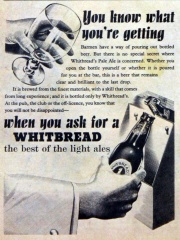of Chiswell Street, near Finsbury Square (1862)
1742 Whitbread and Co was set up by Samuel Whitbread who established a partnership with Thomas Shewell in 1742 but has since ended its brewing activities. Whitbread and Shewell established two breweries, the Goat Brewhouse in the City of London, making porter, and the Brick Lane Brewery of the East End of London, producing paler beers.
1750 The brewing operations were moved to premises in Chiswell Street on the eastern rim of Georgian London, the first purpose-built mass-production brewery in Britain.
By 1760, it had become the second largest brewery in London (producing almost 64,000 barrels annually).
c1761 Samuel Whitbread bought out Thomas Shewell for £30,000 and the brewery became one of the largest brewers of porter in London.
1785 The brewery was also one of the first to employ a steam engine (purchasing a sun and planet gear engine from Boulton and Watt) and still working in 1865
1787 Produced 150,280 barrels
In May 1787 the brewery was visited by King George III and Queen Charlotte.
1796 Whitbread's business was London's biggest producer of beer, producing 202,000 barrels. Key employees were Broughton Maysey, Jacob Yallowly, Robert Sangster and ? Green the chief brewer.
1799 The name Whitbread and Co was taken on.
1800 Additional partners joined the company - Benjamin Hobhouse, Jacob Whitbread and Joseph Godman
1812 Combined with Martineau and Bland
1815 Partners were William Wilshere, John Farquhar, John Martineau, Joseph Martineau and Michael Bland. [1]
1819 William Henry Whitbread and Samuel Charles Whitbread join the partnership
1828 Richard Martineau joins as a junior partner
1831 John Cam Hobhouse becomes a partner
1868 Introduced bottled beer
1889 Became a company. At this time there were 60 licensed houses of which 21 were leasehold, 29 under mortgage and 10 freehold.
Over the next 200 years Whitbread and Co introduced many brands to the UK market, such as Stella Artois and Heineken, alongside its own brands, which grew in popularity in the second half of the 20th century, before declining in the 1990s as people migrated to more international brands such as Fosters and Budweiser.
1976 Beer was last brewed at the Chiswell Street premises.
1989 Acquired Boddingtons
2001 After a long history of brewing, the company, now known as Whitbread Group Plc decided to sell all its breweries and brewing interests (Whitbread Brewing Company) to Interbrew, now known as InBev.
2002 Whitbread sold its pub estate, known as the Laurel Pub Company, to Enterprise Inns, concentrating instead on its hotel (Premier Inns) and coffee-house (Costa) interests.
See Also
Sources of Information
- ↑ Whitbread's Brewery. Published by Whitbread and Co 1951.
- [1] Wikipedia
- "Trademarked. A History of Well-Known Brands - from Aertex to Wright's Coal Tar" by David Newton. Pub: Sutton Publishing 2008 ISBN 978-0-7509-4590-5






















